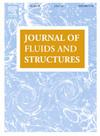Pressure and flow patterns during multiple-order vertical vortex-induced vibrations of a 6:1 rectangular cylinder
IF 3.4
2区 工程技术
Q1 ENGINEERING, MECHANICAL
引用次数: 0
Abstract
Rectangular cross-sections have been typically used to investigate vortex-induced vibration (VIV) mechanism of bluff bodies, which provides important reference for wind-resistant design of engineering structures, such as high-rise buildings and long-span bridges. A numerical simulation was conducted in order to examine the multiple-order vertical VIV mechanism of a 6:1 rectangular cylinder, and the surface wind pressure distribution characteristics and surrounding flow field were particularly focused. This rectangular cylinder has two VIV lock-in regions. According to the surface pressure distribution characteristics, it is deduced from the proposed simplified vortex theory that there are significant vortices drifting on the upper and lower surfaces of the rectangular cylinder, and the vortex experiences approximate two and one vibration period drifting from the leading edge to the trailing edge in the first and second lock-in region, respectively. More characteristics of the flow field are revealed by dynamic mode decomposition (DMD) method. The front three non-zero DMD mode frequencies are about 1–3 times of the natural frequency of the rectangular cylinder, respectively. Multiple vortices are also observed on the upper and lower surfaces in the high-order DMD modes, especially in the second lock-in region, indicating the importance of vortex drifting phenomenon in the occurrence of VIV. This investigation provides a deeper viewpoint combining surface pressure distribution characteristics and surrounding flow patterns, which is of important reference for revealing the VIV mechanism of wind-sensitive structures with bluff body cross-sections.
6:1矩形圆柱多阶垂直涡激振动时的压力和流动特征
矩形截面通常用于研究钝体涡激振动机理,为高层建筑和大跨度桥梁等工程结构的抗风设计提供重要参考。通过数值模拟研究了6:1矩形圆柱的多阶垂直涡激振动机理,重点研究了表面风压分布特征和周围流场。这个矩形圆柱体有两个VIV锁定区域。根据表面压力分布特征,由所提出的简化涡理论推导出,在矩形圆柱的上下表面存在明显的涡漂移,涡在第一和第二锁定区分别经历了从前缘到尾缘的近似两个和一个振动周期漂移。动态模态分解(DMD)方法揭示了流场的更多特性。前三个非零DMD模态频率分别约为矩形圆柱固有频率的1-3倍。在高阶DMD模态中,上下表面也观察到多个涡,特别是在第二锁定区,表明涡漂移现象在涡激振荡发生中的重要性。该研究为揭示钝体截面风敏结构的涡激振动机理提供了一个结合表面压力分布特征和周围流动形态的更深入视角。
本文章由计算机程序翻译,如有差异,请以英文原文为准。
求助全文
约1分钟内获得全文
求助全文
来源期刊

Journal of Fluids and Structures
工程技术-工程:机械
CiteScore
6.90
自引率
8.30%
发文量
173
审稿时长
65 days
期刊介绍:
The Journal of Fluids and Structures serves as a focal point and a forum for the exchange of ideas, for the many kinds of specialists and practitioners concerned with fluid–structure interactions and the dynamics of systems related thereto, in any field. One of its aims is to foster the cross–fertilization of ideas, methods and techniques in the various disciplines involved.
The journal publishes papers that present original and significant contributions on all aspects of the mechanical interactions between fluids and solids, regardless of scale.
 求助内容:
求助内容: 应助结果提醒方式:
应助结果提醒方式:


